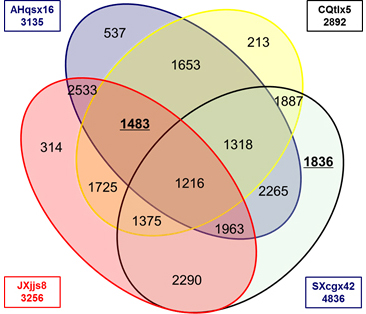

长江流域野生拟南芥种群QTL作图平台的建立
# 共同第一作者
收稿日期: 2016-05-30
录用日期: 2016-07-05
网络出版日期: 2016-09-27
基金资助
国家自然科学基金青年项目(No.31400203)和陕西省自然科学基础研究计划青年人才项目(No.2016JQ3030)
Quantitative Trait Loci Mapping Platform of Natural Populations of Arabidopsis thaliana along the Yangtze River in China
# Co-first authors
Received date: 2016-05-30
Accepted date: 2016-07-05
Online published: 2016-09-27
对模式植物的研究不仅能揭示众多具有普遍规律的生物现象, 而且能为其它植物物种, 特别是与人类生活紧密相关的经济植物提供具有借鉴与参考意义的研究方法。QTL遗传作图是寻找那些影响不同地域植物自然变异等位基因的传统且有效的工作方法。对不同分化时长和不同遗传背景的植物种群, 有针对性地开发特异的分子标记, 一直是QTL遗传作图工作的重要内容。该研究利用二代测序技术得到的全基因组重测序结果, 根据其中鉴定到的结构变异(SV)多态性设计引物, 开发了针对分化时间短、多态性位点少的中国长江流域野生拟南芥(Arabidopsis thaliana)种群的QTL作图分子标记平台, 得到了有效适用的结果, 该方法不仅在模式植物拟南芥中适用, 而且也适用于其它植物。

康菊清 , 张慧婷 , 施逸豪 , 孙田舒 . 长江流域野生拟南芥种群QTL作图平台的建立[J]. 植物学报, 2016 , 51(5) : 659 -666 . DOI: 10.11983/CBB16120
Studies on model plants have not only explored the mechanism of many life phenomenology but also provide research methods for other plants, especially economic plants. Quantitative trait loci (QTL) mapping is an effective method for identifying the alleles contributing to natural variation among populations that might be involved in adaptation in different environments. Exploring enough effective markers for specific mapping populations overcoming the differences of diverging time and genetic background was always the important and challenging part in these works. Here we explored efficient mapping markers by using SVs based on resequencing data of populations of Arabidopsis thaliana along the Yangtze River, a plant group that recently diverged and lacks sufficient genetic diversities. This research approach combining next-generation sequencing and traditional QTL mapping to identify the genetic basis of natural variation is effective for Arabidopsis and for other plants.

| 1 | 种康, 王台, 钱前, 王小菁, 左建儒, 顾红雅, 姜里文, 陈之端, 白永飞, 杨淑华, 孔宏智, 陈凡, 萧浪涛 (2015). 2014年中国植物科学若干领域重要研究进展. 植物学报 50, 412-459. |
| 2 | 康菊清 (2010). 中国野生拟南芥种群冷胁迫响应的分化及其分子机制. 博士论文. 北京: 北京大学. pp. 7. |
| 3 | 邢光南, 赵团结, 盖钧镒 (2008). 关于Mapmaker/Exp遗传作图中标记分群和排序操作技术的讨论. 作物学报 34, 217-223. |
| 4 | 张艺能, 周玉萍, 陈琼华, 黄小玲, 田长恩 (2014). 拟南芥开花时间调控的分子基础. 植物学报 49, 469-482. |
| 5 | Alonso-Blanco C, Aarts MG, Bentsink L, Keurentjes JJ, Reymond M, Vreugdenhil D, Koornneef M (2009). What has natural variation taught us about plant development, physiology, and adaptation?Plant Cell 21, 1877-1896. |
| 6 | Alonso-Blanco C, Bentsink L, Hanhart CJ, Blankestijn- de Vries H, Koornneef M (2003). Analysis of natural allelic variation at seed dormancy loci of Arabidopsis tha- liana.Genetics 164, 711-729. |
| 7 | Alonso-Blanco C, El-Assal SE, Coupland G, Koornneef M (1998). Analysis of natural allelic variation at flowering time loci in the Landsberg erecta and Cape Verde Islands ecotypes of Arabidopsis thaliana.Genetics 149, 749-764. |
| 8 | Alonso-Blanco C, Gomez-Mena C, Llorente F, Koornneef M, Salinas J, Martinez-Zapate JM (2005). Genetic and molecular analyses of natural variation indicate CBF2 as a candidate gene for underlying a freezing tolerance quantitative trait locus in Arabidopsis.Plant Physiol 139, 1304-1312. |
| 9 | Alonso-Blanco C, Koornneef M (2000). Naturally occurring variation in Arabidopsis: an underexploited resource for plant genetics.Trends Plant Sci 5, 22-29. |
| 10 | Alonso-Blanco C, Koornneef M, van Ooijen JW (2006). QTL analysis.Methods Mol Biol 323, 79-99. |
| 11 | Cheo TY, Lu L, Yang G (2001). Brassicaceae. In: Wu ZY, Raven PH, eds. Flora of China. Beijing, China and St. Louis, USA: Science Press and Missouri Botanical Garden Press. pp. 120-121. |
| 12 | Collard B, Jahufer M, Brouwer J, Pang E (2005). An introduction to markers, quantitative trait loci (QTL) map- ping and marker-assisted selection for crop improvement: the basic concepts.Euphytica 142, 169-196. |
| 13 | He F, Kang DM, Ren YF, Qu LJ, Zhen Y, Gu HY (2007). Genetic diversity of the natural populations of Arabidopsis thaliana in China.Heredity 99, 423-431. |
| 14 | He F, Kang J, Zhou X, Su Z, Qu L, Gu H (2008). Variation at the transcriptional level among Chinese natural popu- lations of Arabidopsis thaliana in response to cold stress.Chin Sci Bull 53, 2989-2999. |
| 15 | Hou X, Li L, Peng Z, Wei B, Tang S, Ding M, Liu J, Zhang F, Zhao Y, Gu H, Qu LJ (2010). A platform of high- density INDEL/CAPS markers for map-based cloning in Arabidopsis.Plant J 63, 880-888. |
| 16 | Kang JQ, Zhang HT, Sun TS, Shi YH, Wang JQ, Zhang BC, Wang ZH, Zhou YH, Gu HY (2013). Natural variation of C-repeat-binding factor (CBFs) genes is a major cause of divergence in freezing tolerance among a group of Ara- bidopsis thaliana populations along the Yangtze River in China.New Phytol 199, 1069-1080. |
| 17 | Koornneef M, Alonso-Blanco C, Vreugdenhil D (2004). Naturally occurring genetic variation in Arabidopsis tha- liana.Annu Rev Plant Biol 55, 141-172. |
| 18 | Mitchell-Olds T, Willis JH, Goldstein DB (2007). Which evolutionary processes influence natural genetic variation for phenotypic traits?Nat Rev Genet 8, 845-856. |
| 19 | Weigel D (2012). Natural variation in Arabidopsis: from molecular genetics to ecological genomics.Plant Physiol 158, 2-22. |
| 20 | Weigel D, Nordborg M (2005). Natural variation in Ara- bidopsis. How do we find the causal genes? Plant Physiol 138, 567-568. |
| 21 | Yin P, Kang J, He F, Qu LJ, Gu H (2010). The origin of populations of Arabidopsis thaliana in China, based on the chloroplast DNA sequences.BMC Plant Biol 10, 22. |
/
| 〈 |
|
〉 |